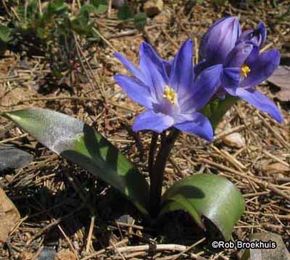The bright blue flowers of the glory-of-the-snow are one of the harbingers of spring, often appearing when snow is still on the ground. The colder the weather, the longer they last. These plants actually do best in cold climates, needing a deep winter rest to bloom properly.
Advertisement
Description of glory-of-the-snow: Chionodoxas are low-growing plants, 4 to 6 inches high, with grasslike leaves that appear at the same time as the flowers. The flowers are star-shaped and face upwards, unlike many other early spring bloomers. They are generally blue with a central white eye. The flowers can last two weeks or more. The leaves fade away in early summer. Ease of care: Easy.
Growing glory-of-the-snow: Plant 3 inches deep, 1 to 3 inches apart, in almost any kind of soil. Full sun to light shade is fine. Moderate shade is necessary in warm climates to keep flowers from fading too quickly.
Propagating glory-of-the-snow: By division or seed.
Uses for glory-of-the-snow: A delightful plant for rock gardens or borders, the glory-of-the-snow really shines when naturalized in lawns and woods where it spreads well without ever becoming weedy.
Glory-of-the-snow related varieties: Pink Giant and Rosea have pink blooms. Alba is pure white. Closely related Puschkinia scilloides is similar but with very pale blue flowers with a blue central stripe.
Scientific name of glory-of-the-snow: Chionodoxa luciliae
Advertisement
